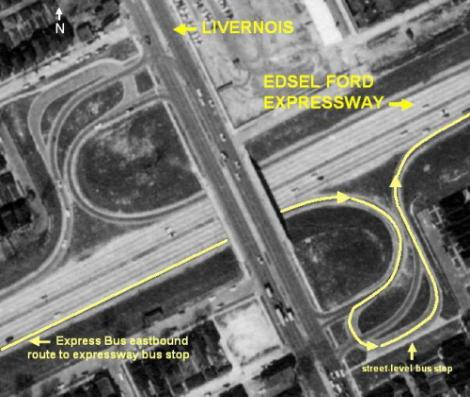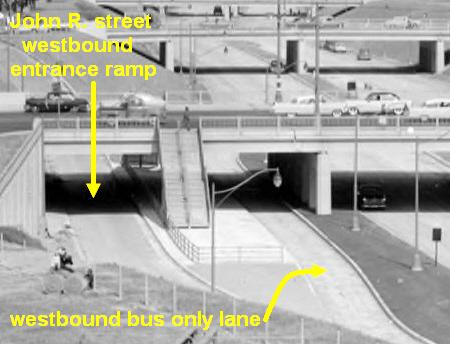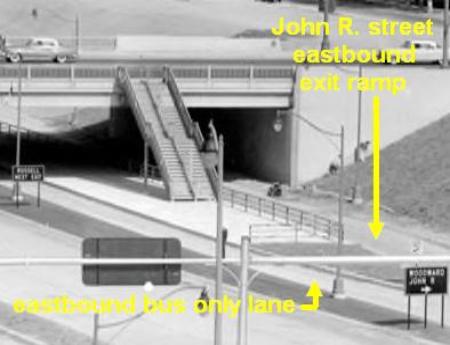So, while looking up some history on Five Points Street I came across
detroittransithistory.info, which I basically stumble over once or twice a year. It's basically the best (and really only) website detailing Detroit's transit history. A little cluttered and sometimes difficult to navigate, it's easy to get lost in.
I came across something I never knew existed, even though there is some evidence staring you right in the face:
bus stops on the Ford Freeway that were supposed to be used for an express bus line that traveled the freeway. These Ford Freeway bus stops (at street-level along Livernois, and freeway-level at Woodward) were actually a compromise upon the building of the freeway in the mid-40's to early-50's. The original plan - the 1945 Detroit Expressway and Transit System by the Detroit Transportation Board - was to include rapid transit within the median of the Ford Freeway, but since Detroit was already into taking up streetcar lines since the 30's, the plan would have also changed most of the streetcar lines along the "spokes" to electric trolley-buses and express buses. At downtown, however, the trolley-buses and existing streetcar lines would have been a subway with some stops terminating under Cadillac Square.
Anyway, the DSR (Department of Street Railways, the precursor to DDOT), ultimately killed this plan in favor of the plan for express bus stops on the Ford. The service that would use at least one of these stops was the
Plymouth Express in 1955. The stop was at Livernois and the Ford:
 (WSU / DTE Aerial Photo Collection)
(WSU / DTE Aerial Photo Collection)
The eastbound stop is shown, but the westbound stop can be seen in the larger ramps on the north side of the interchange. Both bus stops/ramps have long since been removed. There was also a stop at Grand River and the Ford that was removed back in the 70's and a Gratiot stop along the freeway that was never used.
The most notable, though, and the one where the infrastructure is actually still visible is the Woodward stop. It was the only of these stops at freeway-level.
 (MDOT)
(MDOT)


The problem was that the stop was built for an express service that never materialized. The Plymouth Limited, which was mentioned above, turned off at the Lodge to take you downtown, so it never used the stops, either. Built in 1955, by 1960, the DSR demolished them admitting that ridership was already declining and they couldn't justify the new service. Along with the staircases, the westbound station and ramp (north) were subsumed into a wider auto entrance ramp. However, the eastbound station and ramp (south) remain, abandoned, but they remain:

BTW, Detroit proper's last express route (at least to use the freeways) was #78 Imperial Limited, cancelled during the great blood letting of early 2012, when the management of the DDOT was farmed out to Parsons Brinckerhoff, who then farmed it out to the guy that ran Rochester's mass transit authority.
It's funny how you can drive by something multiple times and look at it and never see it. lol This is also a great storing in showing how early Detroit's transit planning turned into a nightmare. It also makes you wonder about what could be, and if proper funding could bring back something as simple as express bus service...



